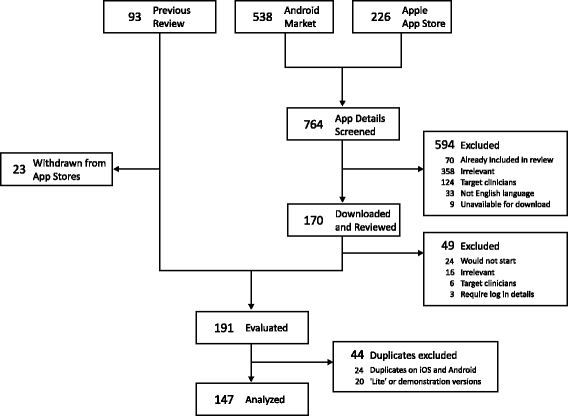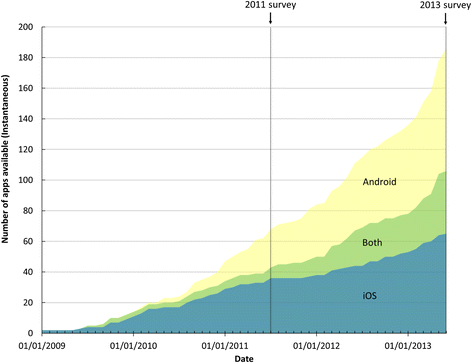The evolution of mobile apps for asthma: an updated systematic assessment of content and tools
- PMID: 25857569
- PMCID: PMC4391129
- DOI: 10.1186/s12916-015-0303-x
The evolution of mobile apps for asthma: an updated systematic assessment of content and tools
Abstract
Background: Interest in mobile apps that support long-term conditions such as asthma is matched by recognition of the importance of the quality and safety of apps intended for patient use. We assessed how changes over a 2-year period affected the clinical suitability of apps providing self-management information and tools for people with asthma by updating a review first performed in 2011.
Methods: Systematic content assessment of all apps for iOS and Android examining the comprehensiveness of asthma information, consistency with the evidence base for asthma self-management and adherence to best practice principles for trustworthy content, comparing the quality of apps available in 2011 to those released since.
Results: Between 2011 and 2013, numbers of asthma apps more than doubled from 93 to 191, despite withdrawal of 25% (n = 23/93) of existing apps. Newer apps were no more likely than those available in 2011 to include comprehensive information, such as the use of action plans, or offer guidance consistent with evidence; 13% (n = 19/147) of all apps, and 39% (n = 9/23) of those intended to manage acute asthma, recommended self-care procedures unsupported by evidence. Despite increases in the numbers of apps targeting specific skills, such as acute asthma management (n = 12 to 23) and inhaler technique (from n = 2 to 12), the proportion consistent with guidelines (17%, n = 4/23) and inhaler instructions (25%, n = 3/12), respectively, was low, and most apps provided only either basic information about asthma (50%, n = 75/147) or simple diary functions (24%, n = 36/147).
Conclusions: In addition to persisting questions about clinical quality and safety, dynamic aspects of app turnover and feature evolution affect the suitability of asthma apps for use in routine care. The findings underline the need for coordinated quality assurance processes that can adapt to changing clinical and information governance-related risks, ensure compliance with the evidence base and reflect local variations in clinical practice. It is unclear if substantial clinical benefits can be realized from a landscape dominated by low quality generic information apps and tools that do not adhere to accepted medical practice.
Figures


Comment in
-
'Trust but verify'--five approaches to ensure safe medical apps.BMC Med. 2015 Sep 25;13:205. doi: 10.1186/s12916-015-0451-z. BMC Med. 2015. PMID: 26404791 Free PMC article.
Similar articles
-
Mobile Phone Apps Targeting Medication Adherence: Quality Assessment and Content Analysis of User Reviews.JMIR Mhealth Uhealth. 2019 Jan 31;7(1):e11919. doi: 10.2196/11919. JMIR Mhealth Uhealth. 2019. PMID: 30702435 Free PMC article.
-
'Can you recommend any good STI apps?' A review of content, accuracy and comprehensiveness of current mobile medical applications for STIs and related genital infections.Sex Transm Infect. 2017 Jun;93(4):234-235. doi: 10.1136/sextrans-2016-052690. Epub 2016 Nov 24. Sex Transm Infect. 2017. PMID: 27884965 Free PMC article.
-
Medication management support in diabetes: a systematic assessment of diabetes self-management apps.BMC Med. 2019 Jul 17;17(1):127. doi: 10.1186/s12916-019-1362-1. BMC Med. 2019. PMID: 31311573 Free PMC article.
-
Smartphone apps for calculating insulin dose: a systematic assessment.BMC Med. 2015 May 6;13:106. doi: 10.1186/s12916-015-0314-7. BMC Med. 2015. PMID: 25943590 Free PMC article. Review.
-
A cross-sectional content analysis of Android applications for asthma.Health Informatics J. 2017 Jun;23(2):83-95. doi: 10.1177/1460458215627289. Epub 2016 Mar 3. Health Informatics J. 2017. PMID: 26940137
Cited by
-
Characterization of Apps and Other e-Tools for Medication Use: Insights Into Possible Benefits and Risks.JMIR Mhealth Uhealth. 2016 Apr 6;4(2):e34. doi: 10.2196/mhealth.4149. JMIR Mhealth Uhealth. 2016. PMID: 27052946 Free PMC article.
-
Refinement of a Parent-Child Shared Asthma Management Mobile Health App: Human-Centered Design Study.JMIR Pediatr Parent. 2022 Feb 17;5(1):e34117. doi: 10.2196/34117. JMIR Pediatr Parent. 2022. PMID: 35175214 Free PMC article.
-
How the Smartphone Is Changing Allergy Diagnostics.Curr Allergy Asthma Rep. 2018 Oct 25;18(12):69. doi: 10.1007/s11882-018-0824-4. Curr Allergy Asthma Rep. 2018. PMID: 30361774 Review.
-
Digital tools in allergy and respiratory care.World Allergy Organ J. 2022 Jun 23;15(7):100661. doi: 10.1016/j.waojou.2022.100661. eCollection 2022 Jul. World Allergy Organ J. 2022. PMID: 35784945 Free PMC article. Review.
-
Patient and Parent Perspectives on Improving Pediatric Asthma Self-Management Through a Mobile Health Intervention: Pilot Study.JMIR Form Res. 2020 Jul 3;4(7):e15295. doi: 10.2196/15295. JMIR Form Res. 2020. PMID: 32442127 Free PMC article.
References
-
- Ofcom. The communications market 2014 (August). 2014. http://stakeholders.ofcom.org.uk/market-data-research/market-data/commun....
-
- Pew Research Internet Project. Mobile technology fact sheet. http://www.pewinternet.org/fact-sheets/mobile-technology-fact-sheet/.
-
- Fox S, Duggan M. Mobile health 2012. Washington DC: Pew Research Center; 2012.
-
- research2guidance. Mobile health market report 2013–2017. http://www.research2guidance.com/shop/index.php/mhealth-report-2.
Publication types
MeSH terms
LinkOut - more resources
Full Text Sources
Other Literature Sources
Medical

